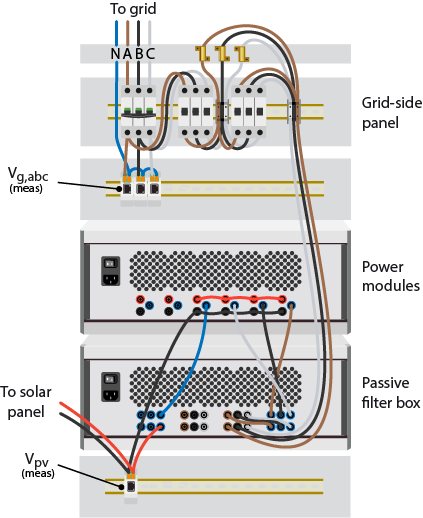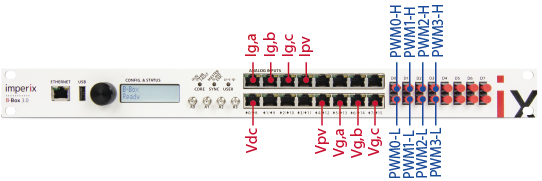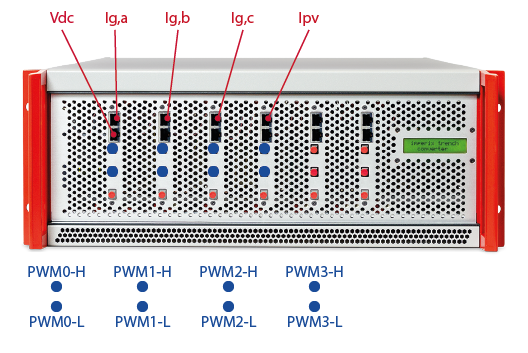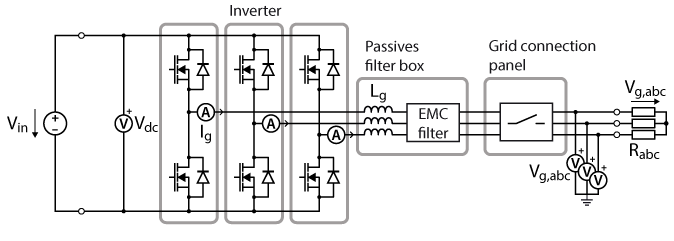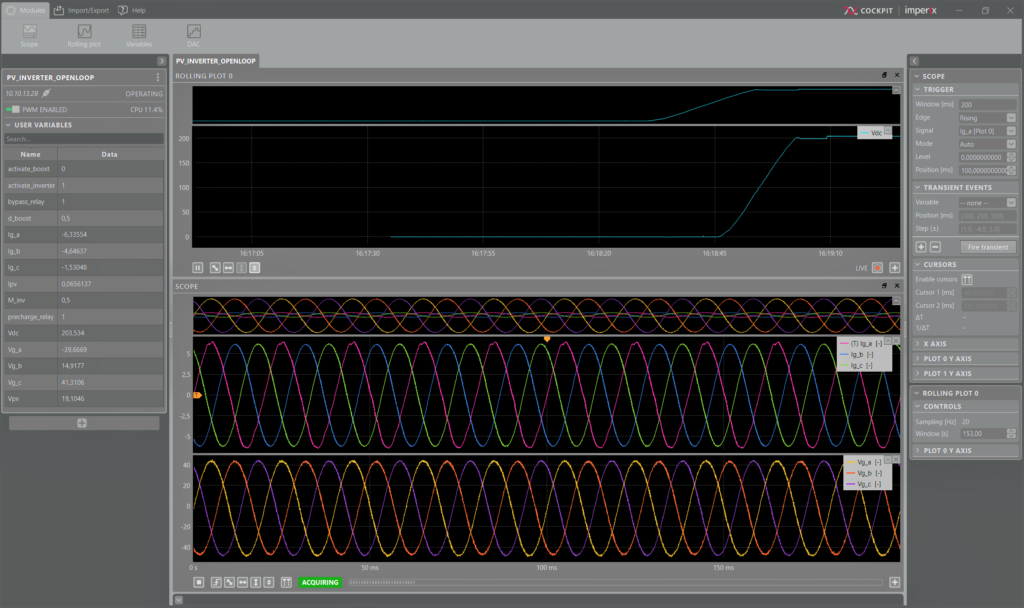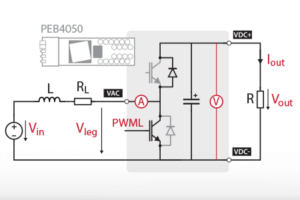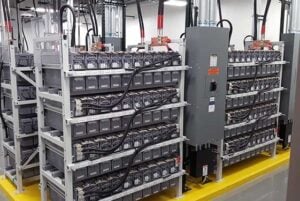Table of Contents
Thanks to its flexibility, the power electronic bundle allows for the implementation of numerous power converter topologies. As an example, this page explains how to get it configured as a 3-phase solar inverter, which is the default configuration of the bundle.
The page focuses on the basic commissioning and provides a comprehensive overview of the hardware configuration and step-by-step instructions. For a more theoretical approach to this application, please refer to the note AN006.
The considered topology, as shown below, is based on a DC/DC boost connected to a 3-phase inverter.
Setting up the power electronic bundle
The content of the power electronic bundle, listed below, includes all the components needed for the implementation of the solar inverter.
- Programmable controller (B-Box RCP)
- ACG SDK toolbox for automated generation of the controller code from Simulink or PLECS
- 6x phase-leg modules (PEB8038, PEB8024 or PEB4050)
- Passives filter box
- Grid connection panel with switchgear and precharge circuit
- 6x voltage sensors
- 4x current sensors
- All necessary RJ45 and fiber optic cables
- 4mm Safety laboratory cables (banana cables)
On top of that, some additional material, listed below, is required to test the system before operating the full converter.
- Laboratory DC power supply (rated for at least 100V, 5A)
- 3x power resistors (5-100Ω) to emulate a load at the grid terminal
Wiring of the power stage
Per default, the power stage is wired as a grid-tied solar inverter as presented in the image below. The photovoltaic panel is connected to a boost stage that charges the DC link of the power modules. Connected to this DC link is a 3-phase inverter tied to the grid.
For the basic commissioning presented in this quick start guide, the photovoltaic panel and the associated relay will be emulated by a DC power supply and the grid will be replaced by a resistive load (3 power resistors).
The illustration below details the wiring corresponding to the schematic above. The solar panel (i.e. the DC power supply) is connected to the first power module through an inductor from the passive filter box. The DC links of the modules are connected together. The middle points of the three other modules are connected through 3 inductors and the EMC filter to the grid-side panel.
Wiring of the control stage
Considering the measurements, the three grid voltages and the solar panel voltage are measured with external sensors mounted at the back of the converter. All currents and the DC link voltage are measured using the modules’ internal sensors.
The two following schematics illustrate the connections for the measurements (in red) and for the PWM signals (in blue). The measurement channels for Vpv and the grid voltages Vg,a, Vg,b and Vg,c must be wired to the external voltage sensors at the back (see “meas” in the wiring above).
Front panel configuration of the B-Box RCP
To ensure that the ratings of the power converter are never exceeded, the hardware protection limits of the B-Box RCP must be configured properly. A detailed explanation of how to compute these limits is given in PN105. Here the limit for the solar panel current and voltage are set to 30A and 600V respectively. These limits correspond to analog signals of 6V and 5.9V. The DC link voltage is limited to 800V. The grid voltage and current are limited to 370V and 25A, respectively. The table below gives the complete configuration of the analog front-end of the B-Box according to the aforementioned limits.
| Measured signal | Sensor type | Input channel number | Low impedance | Gain | Filter | Limit high [V] | Limit low [V] | Disable safety |
|---|---|---|---|---|---|---|---|---|
| \(I_{g,a,b,c}\) | PEB8038 Current | 0,1,2 | no | x4 | no | 5 | -5 | no |
| \(I_{pv}\) | PEB8038 Current | 3 | no | x4 | no | 0.5 | -6 | no |
| \(V_{dc}\) | PEB8038 Voltage | 8 | no | x2 | no | 7.9 | -0.5 | no |
| \(V_{pv}\) | DIN800V | 12 | no | x4 | no | 5.9 | -0.5 | no |
| \(V_{g,a,b,c}\) | DIN800V | 13,14,15 | no | x4 | no | 3.7 | -3.7 | no |
Commissioning the 3-phase solar inverter
Before operating the system, it is always a good idea to test that everything is properly wired and configured. With the help of the Simulink (or PLECS) model below, the following test procedure can be used to check the behavior of the power electronic bundle wired as a 3-phase solar inverter. The test will be performed in two steps: first by checking the correct operation of the inverter stage, and second by including the operation of the boost stage.
These basic models are designed to operate the boost converter and 3-phase inverter individually and in an open-loop configuration. Hence, ADC blocks retrieve the analog measurements for monitoring purposes only. On the other side, PWM blocks, along with the tunable parameters, send PWM signals with the desired duty cycle to the power converter. The relays of the grid connection panel are operated directly with tunable parameters.
Test 1: 3-phase inverter stage
An easy way to test the inverter stage is to operate it in an open-loop fashion on a passive load. The 3-phase inverter is wired according to the following schematic. For more information on 3-phase inverters, please refer to the note on the Voltage Source Inverter (VSI).
A DC power supply should be connected to the DC link of the power modules. Furthermore, three resistors should be set in a star configuration on the AC side of the converter, as shown in the diagram below.
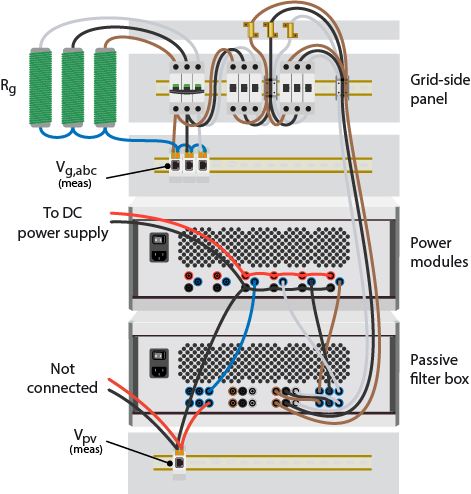
Dimensioning of the load resistors
The theoretical RMS current can be computed as
$$I_{g,rms}=\frac{\sqrt 2\cdot V_{dc} \cdot M_{inv}}{4\cdot\sqrt{R_g^2+(2\pi f L)^2}}$$
where \(V_{dc}\) is the DC link voltage, \(M_{inv}\) the modulation index of the inverter (tunable parameter M_inv), \(R_g\) the resistance of the load, \(f=50\,\text{Hz}\) the AC frequency (hard-coded in the Simulink model) and \(L=2.2\,\text{mH}\) is the equivalent inductance of the passive filter box.
In this guide, \(R_g\) is chosen as \(8.5\,\Omega\), \(M_{inv}=0.5\) and \(V_{dc}=V_{in}=200 \,\text{V}\). This results in an RMS current of \(4\,\text{A}\) through the resistors, which is within the rated current of the selected resistors (\(13.5\,\text{A}\)).
If the rating of the resistor is exceeded, the DC supply voltage and/or the modulation index of the inverter can be reduced accordingly.
Loading the code and setting up the workspace in Cockpit
- In Simulink:
- Open the Simulink model and set the mode to Automated Code Generation in the CONFIG block.
- Build the model (Ctrl + B). It will automatically launch Cockpit.
- Or in PLECS:
- Open the PLECS model.
- Open the coder options (Ctrl + Alt + B) and click Build in the bottom right. It will automatically launch Cockpit.
- In Cockpit:
- Set the target IP in Cockpit and click on Create to generate a new project.
- Add a new rolling plot module and drag and drop the
Vdcvariable to monitor the DC link voltage. - Add a new scope module. Click on the “+” icon on the bottom right of the scope to add a second plot to the scope. Drag-&-drop the grid currents
Ig_a,Ig_bandIg_cto the upper plot and the grid voltagesVg_a,Vg_bandVg_cto the lower plot.
Step-by-step test procedure
- Manually close the circuit breaker on the grid connection panel.
- To let power flow, close the relays of the grid connection panel by setting the variables
precharge_relayandbypass_relayto 1 in Cockpit. - Make sure that
activate_inverterandactivate_boostare 0 so that the converter is not active. - Set the inverter modulation index
M_invto the value selected for the dimensioning of the load resistors (e.g. leave as 0.5 in the case of the present example). - Gradually increase the DC supply voltage to \(200\,\text V\) (or to the value chosen in the dimensioning of the resistors) and check in Cockpit that
Vdcmatches the voltage of the source. - Enable the PWM pulses in the inverter stage by setting
activate_inverterto 1 and by toggling the PWM switch in the upper left corner in Cockpit. - Verify that the AC voltages
Vg_a,Vg_bandVg_care sinusoidal voltages with fundamental amplitude
$$\langle\hat{V_g}\rangle=\frac{V_{dc}}{2}\cdot M_{inv}\ \ (\approx 50\,\text V).$$ - Verify that the AC currents
Ig_a,Ig_bandIg_care sinusoidal currents with fundamental amplitude $$\langle\hat{I_g}\rangle=\frac{V_{dc}}{2}\cdot \frac{M_{inv}}{\sqrt{R_g^2+(2\pi f L)^2}}\ \ (\approx 5.8\,\text A).$$ - Decrease the DC supply voltage to \(0\,\text{V}\) and observe that the DC-link gets discharged (voltage
Vdcshould decrease to 0). - Deactivate the inverter by setting
activate_inverterto 0 and by disabling the PWM pulses with the switch in Cockpit.
The screenshot below shows how the workspace could look in the end, while running the test procedure.
Test 2: Include the boost stage
In order to test the whole 3-phase solar inverter, the boost stage must be operated as well. To do so, the DC power supply should be connected to the PV terminals, as in the figure below. At the grid side, the three resistors must be kept in star connection.

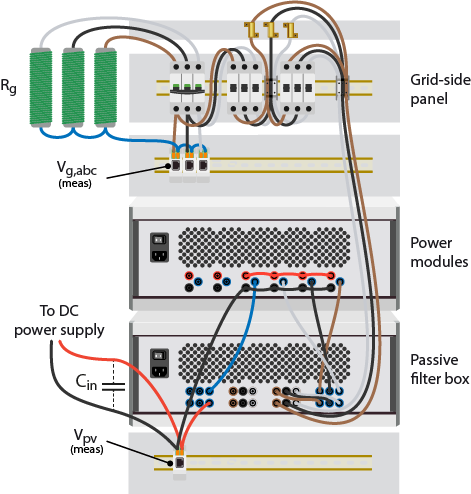
Dimensioning of the load resistors
The theoretical RMS current can be computed as
$$I_{g,rms}=\frac{\sqrt 2\cdot V_{in} \cdot M_{inv}}{4\cdot(1-d_{boost})\cdot\sqrt{R_g^2+(2\pi f L)^2}}$$
where \(V_{in}\) is the DC supply voltage, \(M_{inv}\) the modulation index of the inverter (tunable parameter M_inv), \(d_{boost}\) the duty-cycle of the boost stage (tunable parameter d_boost), \(R_g\) the resistance of the load, \(f=50\,\text{Hz}\) the AC frequency (hard-coded in the Simulink model) and \(L=2.2\,\text{mH}\) is the equivalent inductance of the passive filter box.
In this guide, \(R_g\) is chosen as \(8.5\,\Omega\), \(M_{inv}=0.5\), \(d_{boost}=0.5\) and \(V_{in}=100 \,\text{V}\). This results, as in test 1, in an RMS current of \(4\,\text{A}\) through the resistors, which is within the rated current of the selected resistors (\(13.5\,\text{A}\)).
If the rating of the resistor is exceeded, the DC supply voltage, the duty-cycle of the boost stage and/or the modulation index of the inverter can be reduced accordingly.
Loading the code and setting up the workspace in Cockpit
- In Simulink:
- Open the Simulink model and set the mode to Automated Code Generation in the CONFIG block.
- Build the model (Ctrl + B). It will automatically launch Cockpit.
- Or in PLECS:
- Open the PLECS model.
- Open the coder options (Ctrl + Alt + B) and click Build in the bottom right. It will automatically launch Cockpit.
- In Cockpit:
- Set the target IP in Cockpit and click on Create to generate a new project.
- Add a new rolling plot module and drag-&-drop the variable
VdcandVpvto monitor the DC voltages. - Add a second rolling plot module and drag-&-drop the input current
Ipv. - Add a new scope module. Click on the “+” icon on the bottom right of the scope to add a second plot to the scope. Drag-&-drop the grid currents
Ig_a,Ig_bandIg_cto the upper plot and the grid voltagesVg_a,Vg_bandVg_cto the lower plot.
Step-by-step test procedure
Vdc and the input current Ipv is implemented. Therefore, carefully follow the instructions below to prevent uncontrolled transients from triggering an over-current fault.- Manually close the circuit breaker on the grid connection panel.
- To let power flow, close the relays of the grid connection panel by setting the variables
precharge_relayandbypass_relayto 1 in Cockpit. - Set the inverter modulation index
M_invto the value selected for the dimensioning of the load resistors (e.g. leave as 0.5 in the case of the present example). - Set the boost duty-cycle
d_boostto the value selected for the dimensioning of the load resistors (e.g. leave as 0.5 in the case of the present example). - Make sure that the DC link voltage \(V_{dc}\) is very close to \(0\,\text V\).
- The PWM pulses must be enabled in the inverter stage and in the boost stage. To do so, set the variables
activate_inverterandactivate_boostto 1 and toggle the PWM switch in the upper left corner in Cockpit. - Slowly increase the DC supply voltage to \(200\,\text V\) (or to the value chosen in the dimensioning of the resistors) and check in Cockpit that \(V_{PV}\) matches the voltage of the source.
- Verify that the DC-link voltage \(V_{dc}\) has the expected value $$V_{dc}=\frac{V_{in}}{1-d_{boost}}\ \ (\approx 200\,\text V).$$
- Verify that the AC phase-to-neutral voltages
Vg_a,Vg_bandVg_care sinusoidal voltages with fundamental amplitude
$$\langle\hat{V_g}\rangle=\frac{V_{dc}}{2}\cdot M_{inv}\ \ (\approx 50\,\text V).$$ - Verify that the AC currents
Ig_a,Ig_bandIg_care sinusoidal currents with fundamental amplitude $$\langle\hat{I_g}\rangle=\frac{V_{dc}}{2}\cdot \frac{M_{inv}}{\sqrt{R_g^2+(2\pi f L)^2}}\ \ (\approx 5.8\,\text A).$$ - Verify that the averaged measured input current
Ipvcorresponds to the expected value $$\overline{I_{pv}}=\frac{3\cdot R_g\cdot\langle\hat{I_g}\rangle^2}{2\cdot V_{in}} \ \ (\approx 4.4\,\text A).$$ Note that the measured value might be slightly higher than the theoretical value, due to the simplifications made in the computation (higher harmonics and losses disregarded). - Deactivate the boost stage by setting
activate_boostto 0 and observe thatVdcdecreases until reaching the voltage of the DC supply. - Decrease the DC supply voltage to \(0\,\text{V}\) and observe that the DC-link gets discharged (voltage
Vdcshould decrease to 0). - Deactivate the inverter by setting
activate_inverterto 0.
The screenshot below shows how the workspace could look in the end, while running the test procedure.
Testing of the other power modules
In case it is desired to test all power modules (i.e. not only the first four ones), the above-presented tests should be repeated by shifting the inverter and boost phases (e.g. inverter phases in bays 2-4 and boost in bay 5). In this case, the wiring of the control stage (front of the cabinet) and the power stage (back of the cabinet) must be modified accordingly. Additionally, the channel mapping of the ADC inputs and PWM outputs in Simulink or PLECS must be adapted.
To go further…
With the basic functionality of the equipment tested, one could dive deeper into the control strategy for the 3-phase solar inverter, including its connection to the grid: Three-phase PV inverter for grid-tied applications.




